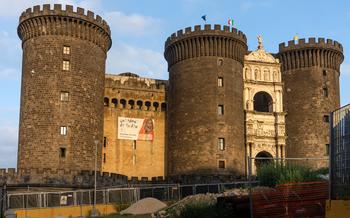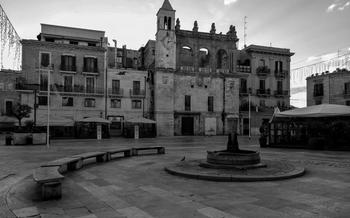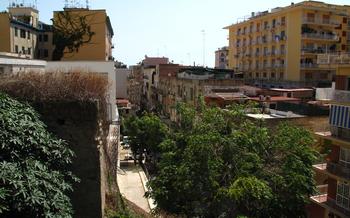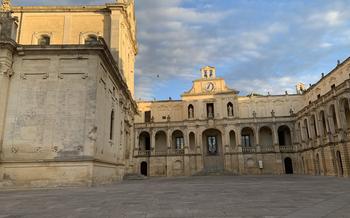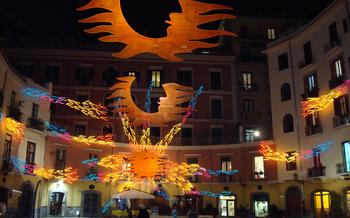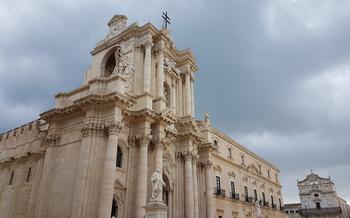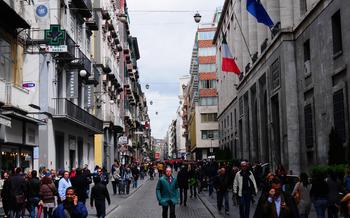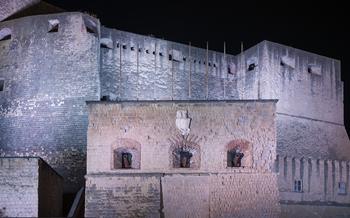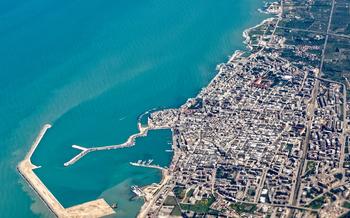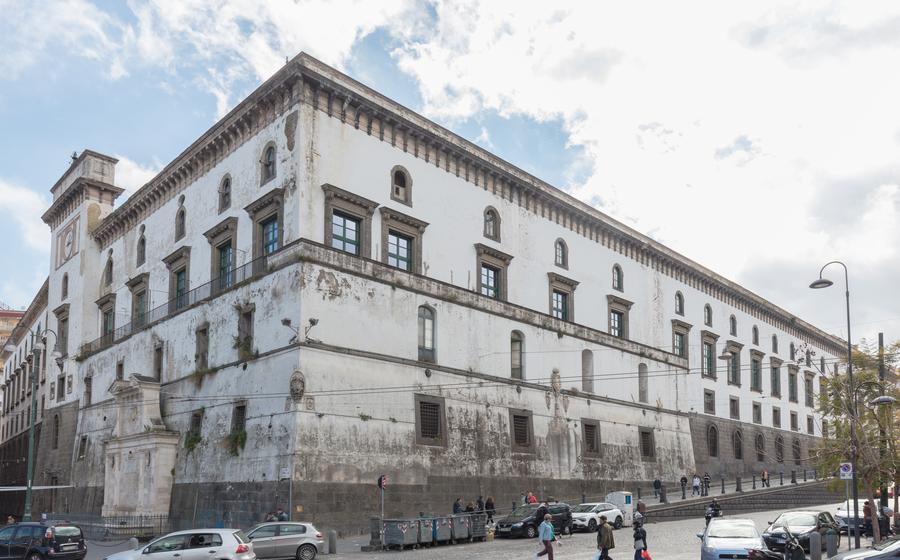
Castel Capuano
- Introduction - The Historical Importance of Castel Capuano
- Renaissance Masterwork - The Porta Capuana
- The Castel Capuano Museum – A Treasure Trove of Neapolitan Art
- Exploring the Grand Hall - Sala dei Baroni
- Hidden Secrets of the Castel Capuano
- The Historical Archives of Naples
- History of the Castel Capuano Grounds
- The Castel Capuano's Role in Neapolitan Uprisings
- The Two Courtyards - Courtyards of Honor and Order
- The Chapel of San Gennaro: A Sacred Haven Within the Fortress Walls
- The Hall of the Vicars - Sala dei Vicari
- The Aragonese Tower - Torre Aragonese
- The Archives of the State of Naples
- The Neapolitan Bar Association
- Insider Tip - Capuano After Dark
Introduction - The Historical Importance of Castel Capuano
Amidst the vibrant tapestry of Naples, a city steeped in history and culture, stands the Castel Capuano, a majestic edifice that has borne witness to the passage of time and played a pivotal role in shaping the city's destiny. This architectural marvel, with its imposing walls and ornate facades, has served as a royal palace, a military fortress, and the seat of the judiciary, leaving an indelible mark on the Neapolitan landscape.
As you step through the gateway of this grand castle, you embark on a journey through the annals of Neapolitan history, where every stone whispers tales of power, intrigue, and transformation. From its medieval origins to its current incarnation as a cultural hub, the Castel Capuano invites you to explore its rich legacy, discover its hidden secrets, and marvel at the artistic treasures that lie within its walls.
Renaissance Masterwork - The Porta Capuana
The Castel Capuano's imposing presence is complemented by the grandeur of the Porta Capuana, a masterpiece of Renaissance architecture that serves as the castle's main entrance. Constructed in 1484 by King Ferdinand I of Aragon, this triumphal arch reflects the transition from Gothic to Renaissance styles. The arch is adorned with intricate carvings, sculptures, and bas-reliefs that depict scenes from mythology, history, and the Bible. The central archway is flanked by two smaller ones, creating a harmonious balance. The Porta Capuana is not just a gateway; it is an artistic statement that embodies the cultural and intellectual awakening of the Renaissance period. Its symbolism as a representation of the new era is unmistakable, as it replaced the medieval city walls and symbolized the opening up of Naples to the world.
The Castel Capuano Museum – A Treasure Trove of Neapolitan Art
The Castel Capuano Museum, housed within the awe-inspiring Castel Capuano, serves as a treasure chest of artistic wonders, showcasing a diverse collection of paintings, sculptures, and decorative art pieces that immerse visitors in the rich cultural heritage of Naples. Among the masterpieces that grace the museum's walls are paintings by renowned Italian artists such as Luca Giordano, Francesco Solimena, and Massimo Stanzione, whose vibrant brushstrokes encapsulate the essence of the Neapolitan School of painting. Renaissance sculptures of exceptional artistry adorn the museum's halls, capturing the grace and elegance of the period. Visitors can feast their eyes on intricate wood carvings, delicate marble statues, and bronze sculptures that exemplify the artistic prowess of Neapolitan craftsmen. The museum's collection also boasts a remarkable array of decorative art pieces, including finely crafted furniture, tapestries, ceramics, and glassware, each item a testament to the refined taste and exquisite craftsmanship that flourished in Naples during the Renaissance era.
Exploring the Grand Hall - Sala dei Baroni
The Castel Capuano's Sala dei Baroni, or Hall of the Barons, stands as a testament to the fortress's grandeur and historical significance. As you step into this magnificent hall, you are greeted by an awe-inspiring spectacle of Renaissance architecture and art. Its vaulted ceiling, adorned with intricate frescoes, narrates historical events that have shaped the identity of Naples, while the walls are lined with armor and weapons that once belonged to the fortress's defenders.
The hall's most striking feature is the fresco cycle that adorns its walls, depicting scenes from the life of King Ferdinand I of Aragon, who played a pivotal role in the history of Naples. These frescoes, painted by renowned Renaissance artists, bring to life the king's triumphs, his battles, and his reign, offering a glimpse into the life and times of a monarch who left an indelible mark on the city.
The Sala dei Baroni served as the main gathering place for justice in the medieval ages. Here, judges dispensed justice, and momentous decisions were made that shaped the fate of Naples and its people. Its grand and imposing atmosphere reminded all who entered that justice was not to be taken lightly, and that the law was the foundation upon which a just society was built.
Hidden Secrets of the Castel Capuano
Veiled within the imposing walls of the Castel Capuano lies a labyrinth of concealed chambers, subterranean tunnels, and secret passages that whisper tales of the fortress's turbulent past. These hidden alcoves, sealed from the public eye, hold the key to unlocking the fortress's untold stories.
One such hidden chamber, known as the "Secret Room," was once used as a meeting place for conspirators plotting against the ruling powers. Its walls adorned with cryptic symbols and encoded messages, it served as a sanctuary for those seeking to undermine the status quo.
Intriguing underground tunnels, meandering beneath the castle's foundations, provided covert routes for messengers to deliver clandestine messages and for the fortress's defenders to move undetected during times of siege. These tunnels, hewn from the bedrock centuries ago, stand as a testament to the ingenuity and resourcefulness of the castle's architects.
Concealed passages, artfully disguised within the fortress's structure, allowed for the discreet movement of people and goods, ensuring secrecy and security in times of turmoil. These hidden routes, known only to a select few, played a crucial role in safeguarding the castle and its inhabitants.
Exploring these hidden realms is like stepping into a time capsule, transporting visitors back to an era of intrigue, subterfuge, and political maneuvering. The Castel Capuano's secret passages offer a glimpse into the fortress's rich history, inviting visitors to unravel the mysteries that lie beneath its imposing façade.
The Historical Archives of Naples
Within the walls of Castel Capuano lies a treasure trove of Neapolitan history - the Historical Archives of Naples. Established in 1808, these archives house a vast collection of invaluable documents that tell the story of the city and its people from the medieval era to the present day. Parchments, manuscripts, and official records from the Kingdom of Naples are carefully preserved here, providing researchers and historians with a glimpse into the city's rich past.
Among the highlights of the collection are documents related to the tumultuous events of the Neapolitan Republic of 1799, a short-lived experiment in democracy that was brutally crushed by the Bourbon monarchy. Letters, proclamations, and other papers offer insights into the ideals and aspirations of the revolutionaries who fought for freedom and independence.
The archives also contain records of daily life in Naples, from tax registers and property deeds to marriage contracts and birth certificates. These documents provide a glimpse into the social and economic fabric of the city, revealing the lives of ordinary people as well as the powerful and influential.
Whether you're a history buff, a genealogist, or simply curious about the past, the Historical Archives of Naples offer a unique opportunity to delve into the rich tapestry of Neapolitan history.
History of the Castel Capuano Grounds
The Castel Capuano stands on a site that has witnessed a rich tapestry of historical events. Its origins can be traced back to ancient Greek times, when a small settlement known as Neapolis was established in the 6th century BC. During the Roman era, the area served as a strategic military outpost, with the construction of a fortress to guard the city's northern flank.
The transformation of the site began in the 11th century under the rule of the Normans, who recognized the strategic importance of the location. They initiated the construction of a castle, which would become the nucleus of the Castel Capuano. Over the centuries, the Normans, Angevins, and Aragonese dynasties left their imprint on the fortress, expanding and fortifying its structures. The castle's strategic position allowed it to withstand numerous sieges and attacks, solidifying its role as a symbol of Neapolitan resilience.
The Castel Capuano's Role in Neapolitan Uprisings
The Castel Capuano has witnessed and played a pivotal role in several significant Neapolitan uprisings throughout its history. In 1647, it became a stronghold for the popular revolt known as the "Masaniello Uprising." Led by the charismatic fisherman Masaniello, the uprising aimed to challenge the oppressive Spanish rule in Naples. The rebels seized the Castel Capuano as their headquarters and used it as a base to coordinate their actions. However, the revolt was short-lived, and the Spanish forces eventually regained control of the city.
Another pivotal moment in Neapolitan history associated with the Castel Capuano was the "Repubblica Partenopea" in 179Inspired by the ideals of the French Revolution, a group of Neapolitan intellectuals and revolutionaries established a short-lived republic in Naples. The Castel Capuano served as a meeting place for the revolutionary government and a prison for political opponents. The republic was ultimately crushed by a joint force of royalist and Austrian troops, marking the end of this chapter in Neapolitan history.
The Two Courtyards - Courtyards of Honor and Order
The Castel Capuano boasts two striking courtyards, each reflecting distinct architectural styles and periods. The Courtyard of Honor, also known as the Grand Courtyard, showcases the grandeur of the Renaissance era. Its harmonious proportions, elegant arcades, and intricate stone carvings create a sense of majesty. The courtyard is adorned with sculptures, fountains, and ornamental details that reflect the artistic sensibilities of the Renaissance.
In contrast, the Courtyard of Order, also known as the Small Courtyard, embodies the Gothic architectural style. Its pointed arches, ribbed vaults, and intricate tracery lend a sense of austerity and strength. The courtyard is characterized by its serene atmosphere, providing a tranquil contrast to the grandeur of the main courtyard. The two courtyards stand as testaments to the architectural diversity and historical significance of the Castel Capuano, offering visitors a glimpse into Naples' rich past.
The Chapel of San Gennaro: A Sacred Haven Within the Fortress Walls
Nestled within the majestic Castel Capuano, the Chapel of San Gennaro exudes an aura of spirituality and artistic brilliance. Dedicated to the patron saint of Naples, Saint Gennaro, this sacred space showcases breathtaking frescoes, paintings, and sculptures that narrate the life and miracles of the revered saint.
Upon entering the chapel, visitors are greeted by a symphony of colors and intricate details adorning the walls and ceiling. The frescoes depict scenes from the saint's life, capturing moments of his martyrdom, his miraculous interventions, and his enduring legacy as the protector of Naples. The vibrant hues and skillful brushstrokes bring the stories to life, inviting viewers to delve into the rich history and devotion surrounding Saint Gennaro.
Among the notable artworks in the chapel is the altarpiece, a masterpiece that depicts the saint's martyrdom. The central figure of Saint Gennaro stands tall, his serene expression contrasting with the dramatic depiction of his impending death. The intricate details of the surrounding figures, the play of light and shadow, and the harmonious composition create a powerful and moving tribute to the saint's unwavering faith.
The Chapel of San Gennaro serves as a sanctuary for prayer and reflection, where visitors can seek solace and inspiration amidst the grandeur of the castle. Its artistic treasures, coupled with the palpable spiritual atmosphere, make it a must-visit destination for those seeking a deeper connection with the history and culture of Naples.
The Hall of the Vicars - Sala dei Vicari
The Sala dei Vicari, also known as the Vicars' Hall, holds a significant place within the Castel Capuano. This grand hall served as a crucial meeting place for the vicars, who were representatives of the king responsible for administering justice in the realm. The hall's architectural design is a testament to its importance, featuring intricate vaulted ceilings, elegant columns, and elaborate frescoes adorning its walls. These artistic masterpieces depict scenes from history and mythology, creating a visually captivating ambiance that enhances the hall's grandeur.
As one steps inside the Sala dei Vicari, they are greeted by a sense of awe and admiration. The hall's spaciousness and carefully curated décor create an atmosphere conducive to serious deliberations and decision-making. The paintings and frescoes that adorn the walls depict historical events and allegorical figures, serving as a constant reminder of the responsibilities and obligations that the vicars shouldered.
Beyond its aesthetic significance, the hall also holds historical importance. It has witnessed countless meetings, debates, and rulings that have shaped the course of Neapolitan law and governance. The echoes of past conversations and the wisdom of those who once gathered within these walls linger in the air, creating a tangible connection to the rich history of the Castel Capuano.
The Aragonese Tower - Torre Aragonese
The Aragonese Tower, also known as Maschio Angioino, is a formidable presence within the Castel Capuano complex. Built in the 15th century under the reign of King Alfonso V of Aragon, it stands as a testament to the fortress's defensive capabilities. Its strategic location, situated at the convergence of the two courtyards, allowed for effective surveillance and control over the surrounding area.
Ascend the tower's winding staircase to reach its summit and be rewarded with breathtaking panoramic views. From this vantage point, the city of Naples unfolds before you, with its vibrant tapestry of terracotta rooftops, the majestic silhouette of Mount Vesuvius, and the shimmering waters of the Bay of Naples.
Explore the tower's interior chambers, where you'll encounter remnants of its former military function. Discover secret passageways and hidden rooms that whisper tales of the fortress's turbulent history. Immerse yourself in the stories of sieges and battles, as the tower's sturdy walls silently stand witness to the passage of time.
The Archives of the State of Naples
Within the Castel Capuano's historic walls lies another treasure trove of historical documentation: the Archives of the State of Naples. This esteemed institution houses a vast collection of manuscripts, maps, and official records that chronicle the rich history of the Kingdom of Naples.
The archives serve as a gateway to the past, preserving documents that date back to the medieval era. Researchers and history enthusiasts alike delve into these invaluable records, uncovering insights into the political, economic, and social fabric of Naples throughout the centuries.
Among the treasures housed within the archives are ancient parchments, royal decrees, and meticulously drafted maps. These documents provide a tangible connection to the past, allowing visitors to trace the evolution of Naples from a small settlement to a thriving metropolis.
The Archives of the State of Naples stand as a testament to the enduring legacy of the city. Its collection of historical documents offers a unique perspective on the cultural, political, and social forces that have shaped Naples into the vibrant and captivating city it is today.
The Neapolitan Bar Association
The Neapolitan Bar Association, also known as the Ordine degli Avvocati di Napoli, plays a significant role in the city's legal community. Founded in the early 19th century, the association represents and protects the interests of lawyers practicing in Naples. It is responsible for upholding professional standards, providing continuing education opportunities, and promoting the legal profession within the region.
The Neapolitan Bar Association has a strong connection to the Castel Capuano. The association's headquarters are located within the castle grounds, where it occupies several rooms and offices. This proximity to the seat of the judiciary has fostered a close relationship between the association and the legal institutions of Naples.
The Neapolitan Bar Association organizes various events and initiatives throughout the year. These include conferences, seminars, and workshops on a wide range of legal topics. The association also hosts social events and networking opportunities for its members.
If you are a lawyer visiting Naples or have an interest in the legal profession, it is worth considering contacting the Neapolitan Bar Association. The association can provide valuable information and resources, as well as opportunities to connect with other legal professionals in the city.
Insider Tip - Capuano After Dark
To fully immerse yourself in the charm of Castel Capuano, consider visiting after dusk. The fortress takes on a different persona under the moonlight, exuding an air of mystery and enchantment. Take advantage of the opportunity to experience the castle in a unique light, free from the daytime crowds.
Guided tours are available in the evening, providing an intimate glimpse into the fortress's hidden corners and unveiling its untold stories. Stroll through the dimly lit courtyards, where history whispers in the shadows, and allow the tales of old to transport you back in time.
Throughout the year, Castel Capuano hosts a variety of cultural events and concerts after dark. These events offer a delightful blend of art, music, and history, creating a magical atmosphere within the fortress walls. Check the castle's official website or local event listings to find out what's happening during your visit.
Whether you opt for a guided tour or simply wander the grounds at your own pace, experiencing Castel Capuano after dark is an unforgettable adventure. Embrace the tranquility of the night, let your imagination soar, and discover the hidden treasures that emerge under the cloak of darkness.
